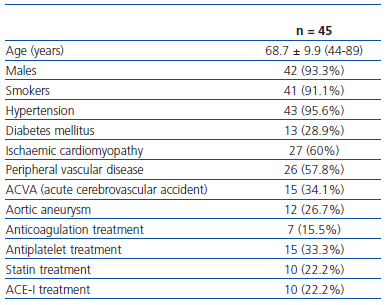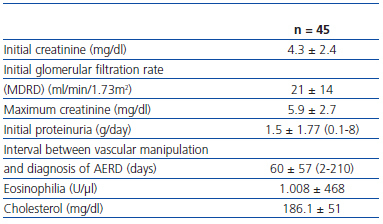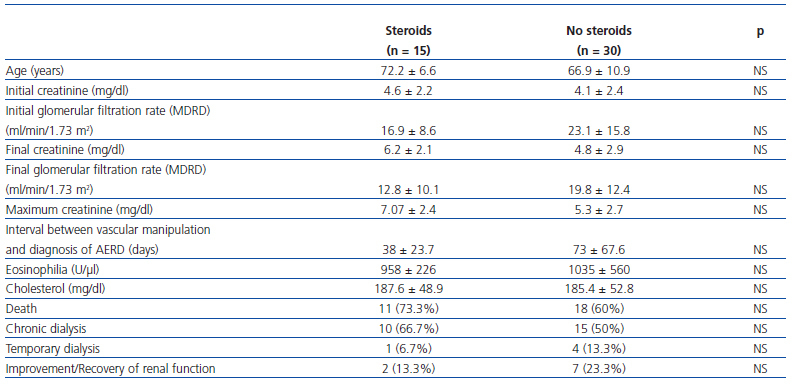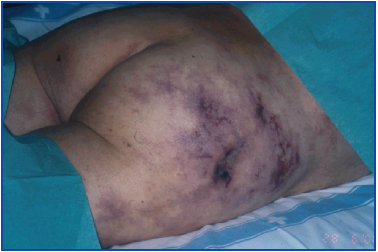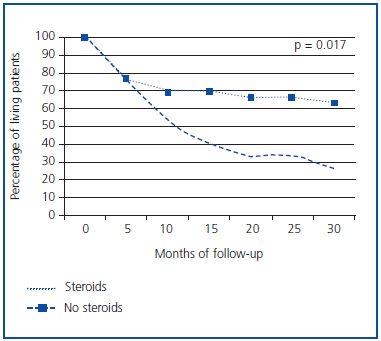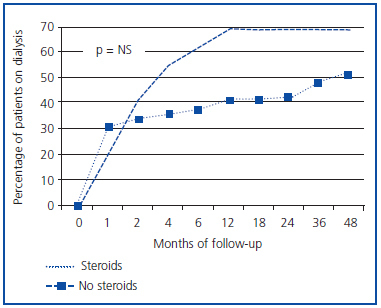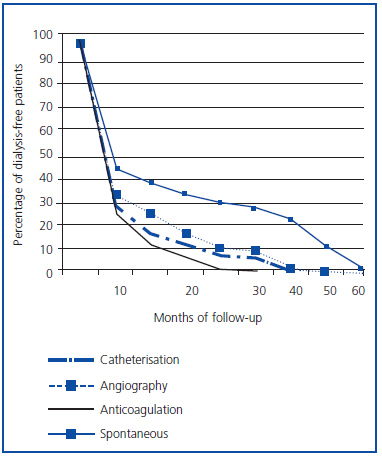Cholesterol embolism is a disease caused by distal showering of cholesterol crystal released from disintegration of arterial atheromatous plaques. It may occur spontaneously or more often after invasive vascular procedures or thrombolytic/anticoagulant agents. Forty five cases were diagnosed between 1989 and 2005 in three Spanish hospitals. The diagnosis was confirmed by histology or diagnostic ophthalmoscopic findings. The majority were male (93.3%), elder (55.5% were older than 70 years), smoker (91.1%), had hypertension (95.6%), with high prevalence of cardiovascular risk factors. At the time of diagnosis all patients presented acute renal failure. Mean serum creatinine at diagnosis was 4.3± 2.4mg/dl. The acute renal failure was accompanied with eosinophilia (64.4%) and cutanous lesions (57.7%). 20% of cases occur spontaneously and 46.7% after endovascular manipulation (coronary angiography/arteriography) and only 8% after changes in anticoagulant treatment. After a follow-up of 12 ± 16.3 months the 55.6% of patients need chronic dialysis, 64.4% died, 8 of them after the beginning of dialysis. Nine patients recovered renal function, with a mean creatinine of 3 ± 1.7 mg/dl at the end of follow-up. The cardiovascular comorbididy and the clinical severity of the embolism don´t have impact in the renal or patient survival. Renal survival (Kaplan-Mier) were better in spontaneous than in iatrogenic cholesterol embolism. Fifteen of 45 patients were treated with steroids. In treated patients we observed a high incidence of death (73.3% versus 60%) and fewer recovery of renal function (13.3% versus 23%), without statistical significance. The mean time to dialysis was shorter in treatment patients (p= 0.017). Statins treatment was not associated with outcome (renal or individual). In summary, atheroembolic renal disease represents an acute renal failure with special characteristics. Renal and individual outcome is poor, but some patients have spontaneous recovery of renal function. Renal survival was significantly better in spontaneous disease. We don´t observe beneficial effect of steroid treatment.
El embolismo de colesterol es una enfermedad causada por la suelta de cristales de colesterol desde las placas arterioscleróticas ulceradas de la aorta. Esta suelta puede ocurrir de forma espontánea o más frecuentemente tras procedimientos vasculares invasivos o tras tratamientos anticoagulantes o fibrinolíticos. Entre 1989 y 2005, en tres hospitales españoles, se diagnosticaron 45 casos de embolismo renal de colesterol. El diagnóstico fue confirmado mediante biopsia de cualquier órgano afectado o hallazgos típicos en el fondo de ojo. La mayoría de los pacientes eran varones (93,3%), ancianos (el 55,7% era mayor de 70 años), fumadores (91,1%), hipertensos (95,6%) y con varios factores de riesgo cardiovascular. Todos los pacientes presentaron un fracaso renal agudo en el momento del diagnóstico. La creatinina media al inicio fue de 4,3 ± 2,4 mg/dl. El fracaso renal agudo se acompañó frecuentemente de eosinofilia (64,4%) y lesiones cutáneas (57,7%). El 20% de los casos ocurrieron espontáneamente y el 46,7% tras manipulación endovascular (cateterismo/arteriografía); tan sólo un 8,9% ocurrió tras cambios en la anticoagulación. Tras un seguimiento de 12 ± 16,3 meses, el 55,6% (25) de los pacientes requerían diálisis crónica y un 64,4% (29) había fallecido, ocho de ellos tras haber entrado en diálisis crónica. Se observó una recuperación parcial de función renal en 9 pacientes (20%), que presentaban una creatinina media al final del seguimiento de 3 ± 1,7 mg/dl. La comorbilidad cardiovascular y la gravedad clínica del embolismo de colesterol no tuvieron impacto sobre la supervivencia renal o del individuo. La supervivencia renal (Kaplan-Meier) fue mayor en los casos de ateroembolismo espontáneo que en los iatrogénicos. 15 de los 45 pacientes recibieron esteroides. En los tratados se observó una mayor incidencia de fallecimientos (73,3% frente a 60%) y un menor porcentaje de recuperación de función renal (13,3% frente a 23%), aunque sin diferencias estadísticamente significativas. El tiempo medio de evolución a la diálisis fue significativamente más corto entre los tratados con esteroides (p = 0,017). El uso de estatinas no se asoció con una mejoría en el pronóstico renal o vital del individuo. En conclusión, la enfermedad renal ateroembólica constituye un tipo de fracaso renal agudo con unas características clínicas muy determinadas. La supervivencia renal y del paciente es mala, pero existe un porcentaje significativo de recuperaciones espontáneas de la función renal. La supervivencia renal fue significativamente mejor en los casos espontáneos y no observamos efectos beneficiosos del tratamiento esteroideo.
INTRODUCTION
Renal cholesterol embolism is part of a systemic disease, triggered by the release of cholesterol emboli from the aorta to multiple organs, where they obstruct small arterioles. Involvement of the kidneys is frequent due to their close proximity to the aorta and the high blood flow that they receive.1
Atheroembolic renal disease (AERD) is a disease with unknown but clearly increasing prevalence.1 The incidence of this disease is related to the degree of atherosclerosis of the aorta and its degree of ulceration. Thurlbeck MW et al., in a series of autopsies, described an incidence ranging from 77% to 4% depending on the degree of atherosclerosis of the aorta.2 It may occur spontaneously but it is usually triggered by invasive vascular procedures or anticoagulants or fibrinolytic treatments.3 Its incidence is increasing due to aging of the population and the spread of invasive techniques. Despite advances in its diagnosis, it remains a disease with high rates of morbidity and mortality for which no effective treatment exists.4
This retrospective series describes the baseline characteristics and progression of 45 patients with histologically confirmed renal cholesterol embolism between 1989 and 2005. The aim of this study is to analyse the predisposing factors for its development, as well as its longterm outcome and prognostic factors.
MATERIAL AND METHODS
This retrospective study included 45 cases of AERD, recruited from three Spanish hospitals (Hospital Parc Taulí de Sabadell, Hospital 12 de Octubre, and Ciudad Real General Hospital) between 1989 and 2005. The data on 19 patients from one centre have been previously published.5 We included all cases diagnosed as AERD at those hospitals. Patients were identified due to deterioration of renal function. The diagnosis was confirmed with biopsy of any affected organ or by the typical findings upon eye fundus examination. The diagnosis of spontaneous AERD was established when the biopsy or the fundus showed cholesterol crystals and there had been no prior invasive procedures or start/change in anticoagulation.
Baseline data was collected at the time of renal biopsy using a common protocol. The variables included were: age, sex, hypertension, diabetes, smoking history, history of cardiovascular disease, dyslipidaemia, and treatment history (antihypertensives, statins, anticoagulants, and antiplatelet drugs). Cardiovascular factors considered were: ischaemic heart disease (angina or previous myocardial infarction), peripheral artery disease (intermittent claudication, previous surgery of lower extremity for arterial ischaemia, imaging evidence of stenosis of lower extremity arteries), cerebral ischaemia, and abdominal aortic aneurysm. The laboratory data included a complete blood count, routine biochemical testing (glucose, creatinine, cholesterol, liver function) and urine analysis with 24-hour proteinuria. The glomerular filtration rate was calculated using the MDRD-4 formula. At follow-up, laboratory and clinical data were recorded, as well as treatment for each patient.
The events collected during follow-up were improvement (defined by a 30% decline in the initial creatinine level), worsening renal function (increase of 30% from the initial creatinine), need for dialysis (chronic or temporary), and death of the patient.
With regard to treatment, the treatment received, the time at which it was started and when it ended, the dose administered, and the possible complications associated with it were all collected.
In the statistical analysis, quantitative values were expressed with mean and standard deviation. The quantitative and qualitative variables were compared with Student’s t-test and Chi-square test. Progression from diagnosis to dialysis or death was described through the Kaplan-Meier method. Cox regression was used for multivariate analysis.
RESULTS
Baseline characteristics
The demographic characteristics and laboratory baselines of this group are described in Tables 1 and 2. Most patients were male (93.3%) and older than 60 years of age (86.7%). All patients had acute renal impairment at the time of diagnosis, with a mean creatinine of 4.3mg/dl (1.3 to 11mg/dl). Most of them also had eosinophilia (64.4%) and skin lesions (57.7%). The lesions observed were livedo reticularis (50%), cyanosis (34.6%) and ulcers (15.4%). These lesions were located mainly on the legs and feet (Figure 1).
One third of patients had involvement of other vascular territories, and the organ most commonly affected was the small intestine (67%).
In 9 cases, the atheroembolism occurred spontaneously. In the remaining 36 patients a triggering event was found: in 18/45, catheterisation had been performed; in 12/45, angiography; in 4/45, changes in anticoagulation; in one patient, cardiac surgery had been performed, and in one patient, there was a history of recent myocardial infarction. In patients with a history of angiography/catheterisation, other causes of acute renal failure (contrast nephrotoxicity) were ruled out. The time elapsed since this procedure was sufficiently long to rule out this aetiology.
All patients included in the study had confirmation of their diagnosis of atheroembolism. This was confirmed by renal biopsy in 19 patients (42.2%), skin biopsy in 10 (22.2%), fundus evaluation in 8 (17.8%), autopsy in 4 (8.9%), through colonic biopsy in two patients, in one patient by muscle biopsy, and in one patient by prostate biopsy. At the time of diagnosis, renal biopsies showed significant signs of chronicity. Forty-two percent of the glomeruli were globally sclerosed. Crescents were observed in two of those patients. Sixty-one point five percent of patients had grade II-III/IV tubular damage. Crystals were located mainly in the arterioles (76.9%).
Renal progression and survival
Mean follow-up time was 12.1 ± 16.3 (1-72) months. The initial creatinine was 4.3 ± 2.4mg/dl and 30 patients required acute haemodialysis within the first 12 months of diagnosis. Of these, 5 patients recovered renal function, while the rest remained on chronic dialysis. At follow-up, 25 (55.6%) patients needed haemodialysis. The average time to enter chronic dialysis was 6.6 ± 12.3 (1-48) months. Nine patients had recovery of renal function. The characteristics of these patients are reflected in Table 3. The average age of these patients was 73.6 ± 10.1 years; their initial creatinine was 4.4 ± 1.8mg/dl and final creatinine was 3.06 ± 1.7mg/dl. Twenty-nine patients (64.4%) died, eight of them after starting chronic dialysis. The average time to death was 21.6 ± 30 (1-131) months. The main cause of death was cardiovascular (14 patients): 9 patients died of multiple organ failure and six from infectious complications. In 16 patients the cause of death was unknown.
Patients who developed spontaneous atheroembolism had a lower percentage of deaths and of patients ending the study in dialysis compared with patients who developed atheroembolism after a triggering event (Table 3). Renal survival without dialysis was significantly better in the spontaneous cases (p = 0.001), as shown in Figure 2.
In 10 patients (22.2%), statin therapy was started after diagnosis and 15 (33.3%) were started on angiotensin converting enzyme inhibitors. None of these treatments was associated with significant improvement in renal progression or individual survival. Fifteen patients (33.3%) were treated with steroids. There were no significant differences in presentation between patients who received steroids and those who were not treated, although the former had slightly worse renal function when the acute renal failure was detected (Table 4). We found no positive influence of steroid therapy on kidney function or with regard to patient survival. As shown in Table 4 and Figures 3 and 4, the percentage of patients requiring chronic dialysis and the number of deaths was higher among those treated with steroids, although the difference did not reach statistical significance. The percentage of patients with renal function recovery was also higher among those who received steroids (Table 4). Meanwhile, the use of steroids was associated with more rapid progression to death (p = 0.017) (Figure 2).
DISCUSSION
Cholesterol atheroembolism is a disease with very poor prognosis both for the kidneys and overall for the patient’s life. It predominantly affects elderly men with severe arteriosclerosis. Ninety percent of patients were smokers. Most were hypertensive, and over 50% had a history of ischaemic heart disease and chronic lower limb ischaemia. The most common presentation is acute or subacute renal failure with eosinophilia and skin lesions, which usually occurs after endovascular manipulation. Hypercholesterolaemia, contrary to what one may think, is not a risk factor for the development of this disease.
Cholesterol atheroembolic disease is caused by obstruction of small calibre vessels (150-200μm) by cholesterol crystals.7 Ischaemic and inflammatory lesions are seen distal to the obstruction.3 The crystal lodged in the lumen causes a granulomatous inflammatory reaction, with infiltration of macrophages and giant cells. This inflammation causes endothelial damage that then results in intimal proliferation and fibrosis. These reactions trigger obliteration of the vascular lumen. These crystals are usually released from atherosclerotic plaques in the aorta. Dislodging of these arteriosclerotic plaques may occur spontaneously after a vascular injury (catheterisation, angiography, surgery).8 Ulcerated arteriosclerosis of the aorta is responsible for atheroembolic disease. Because of this, conventional risk factors for arteriosclerosis (age, male sex, tobacco use, hypertension, etc.) are the same as for the development of AERD.
The kidneys are the most frequently affected organ, along with the intestines and the skin. This common condition is due to its proximity to the aorta and the high blood flow that they receive.3
The most common extrarenal manifestations are cutaneous (57.7%), but it is noteworthy that one third of patients also have other affected areas. Autopsy series show that there is generally multi-organ involvement. The kidney is the organ most commonly affected, followed by the spleen, pancreas, intestine, adrenal glands, liver and other organs.6 Thus, no renal biopsy is necessary in many cases, as findings in other, more accessible organs (skin) are sufficient for diagnosis. The extrarenal area most frequently affected in our series was the small intestine, in the form of gastrointestinal bleeding or chronic intestinal ischaemia. In one of the patients, cholesterol embolism was diagnosed by finding crystals on a prostate biopsy. This extrarenal involvement affects the progression of the disease, increasing comorbidity. Belefant et al. described a high rate of malnutrition and inflammation in these patients, even requiring enteral or parenteral nutritional support.7
One point to highlight in our series is the fact that the triggering factor of the atheroembolic event determines, in part, the subsequent progression. The group in which AERD occurred spontaneously had lower rates of mortality and need for dialysis than other groups (Table 5). Renal survival without dialysis was also significantly better among these patients (Figure 4). Similar results have been described by Scolari et al. in a multicentre study of 354 patients.8 The presentation of patients with spontaneous AERD is subacute/chronic renal failure, possibly caused by the continuous slow release of crystals from the ulcerated plaque. Diagnosis is more difficult in these cases because the symptoms can be non specific, even simulating a vasculitis.9 In this cohort, the renal progression of iatrogenic AERD is worse than spontaneous AERD. In the spontaneous onset group, 18% of patients required dialysis, compared to 37.2% of the iatrogenic group (p = 0.001).8
The fundamental problem of this disease is that, despite its poor prognosis, we do not have any effective treatment. There is no prospective study in the literature that assesses treatment effectiveness. There are reported cases in which improvement in renal function has been achieved with statins,10,11 steroids,12,13 prostaglandins,14 and even with LDL apheresis.15,16 It should be clarified, however, that the attribution of therapeutic success to these measures is based on the widespread belief of the irreversibility of renal failure in AERD. However, there is a case report describing spontaneous recovery of renal function,17 and our series confirms this: nine patients (20%) in our series showed improved renal function and only two of them had received steroids. This recovery, therefore, may be regarded as spontaneous and not attributable to any specific therapeutic measure. In those cases of spontaneous recovery, two patients needed haemodialysis initially due to severe deterioration of renal function. The group of patients who improved showed no differences in terms of demographic or clinical characteristics compared with the group that did not improve, as shown in Table 3. It is possible that some factors, such as the number of arterioles occluded by crystals, the degree of prior nephroangiosclerosis, the severity of tubular necrosis that can accompany AERDinduced ischaemia, and general supportive treatment, could all affect the chances of renal function recovery, but to date we have no data predictive of recovery, apart from the aforementioned better outcomes from spontaneous AERD. Regarding the possible indication for steroid therapy, it is striking that the percentage of patients who improved was higher among the group of patients not receiving steroid treatment, as shown in Table 4. Although there are clinical cases in the published literature describing renal function improvement with steroid,12,13 in our series, those patients treated with steroids had worse renal survival than those patients who did not receive steroids (Figure 3). At the end of follow-up, the percentage of patients on dialysis and who had died was higher in the group treated with steroids.
Similar results were previously described in 1987 in a study of 221 cases where all patients who received steroids died.6 With regard to statins, in our series they did not provide a benefit in terms of patient outcomes. It is noteworthy that the number of patients on statin therapy is small. Possibly the lack of effect of statins in our series is due to the small number of patients receiving this treatment. Despite this result, there is evidence in the literature of the beneficial effect of these drugs. Scolari et al. described how the use of statins was independently associated with a lower risk of progression to chronic renal failure.18 This beneficial role of statins is likely due to stabilisation of the atherosclerotic plaque and, therefore, decreased release of cholesterol crystals into the circulation.19
In conclusion, AERD has poor renal prognosis and high mortality. However, a significant percentage of patients (20% in our series) partially recovered renal function in the absence of specific treatment. Patients with spontaneous AERD had better overall outcomes than iatrogenic cases. There is currently no effective treatment for this disease. Data from our series does not appear to indicate the use of steroids, since they worsened renal progression and individual survival. This should be evaluated in larger groups of patients and prospectively followed. However, despite the fact that in our series statins did not improve prognosis, their use is indicated in this disease, since they have a known beneficial role in stabilising the atherosclerotic plaque. Therefore, treatment of this disease should be based on comprehensive supportive treatment, including the use of statins and avoidance, whenever possible, of anticoagulants or invasive vascular procedures. individual survival. This should be evaluated in larger groups of patients and prospectively followed. However, despite the fact that in our series statins did not improve prognosis, their use is indicated in this disease, since they have a known beneficial role in stabilising the atherosclerotic plaque. Therefore, treatment of this disease should be based on comprehensive supportive treatment, including the use of statins and avoidance, whenever possible, of anticoagulants or invasive vascular procedures.
Table 1. Baseline characteristics
Table 2. Baseline laboratory results
Figure 1. Cutaneous lesions secondary to cholesterol atheroembolism
Table 3. Patient characteristics according to whether or not recovery of renal function occurred over the course of follow-up
Figure 2. Kaplan-Meier survival curve for individuals (steroids/no steroids)
Table 4. Differences between patients who received steroids and those who did not receive steroids
Figure 3. Kaplan-Meier survival curve to dialysis (steroids/no steroids).
Figure 4. Kaplan-Meier dialysis-free survival curve (according to triggering event).
Table 5. Progression according to triggering event


